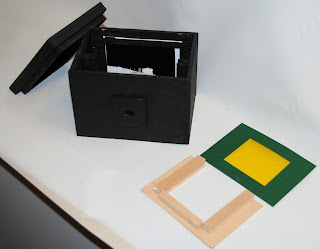The afternoon looked bright so at 12:30 I made my way to CHD. The the clouds came in.
This is what happens if the lid is not fully secured when being removed from the changing bag. But what is has shown is that may be I should pre-flash the paper to reduce the contrast. I have read about this but here I see the dark areas are not as dark where the flash occurred and there is still an image. Some experimentation required.
I went over to the railway trucks but with no sun shining and a 12 minute exposure the is do detail in the dark areas.
Walking a short distance from where the previous shot was taken is the Ropery. Again no sun and 12 minute exposure.
This was quite an experiment as there were seagulls flying around and landing on the timbers just in front of the camera but no effect to the image at all. The tide was going out but even that has not spoilt the photo nor the slight movement of the floating boats.
This amazing building showing so much movement since construction just had to be one of the photos even thought the light was now indicating a 24minute exposure so no detail in the dark areas but interesting if only for the moving branches in the foreground.
All the photos had the yellow filter and the graduated filter in place.
Sorry about the dust on the filters which showed up much more than I would have expected.
So what have I learned from the afternoon.
1. For pinhole exposure one does need sun light
2. Make sure filters are clear of dust particles
3. Have a second pinhole camera ready to take the next shot whilst preparing the other camera.
4. Have two "different" boxes in the changing bag, one for the exposed negatives and one for the unexposed
5. Check that you are putting the paper negative in with the sensitive side towards the lens else NOT IMAGE. I think I will nick of the top right hand corner of the paper so that it indicate the correct way round.
6. Always take photos as one may have unexpected results.
Finally all in all the camera worked as designed and could be loaded and unloaded easily in the changing bag.

















































